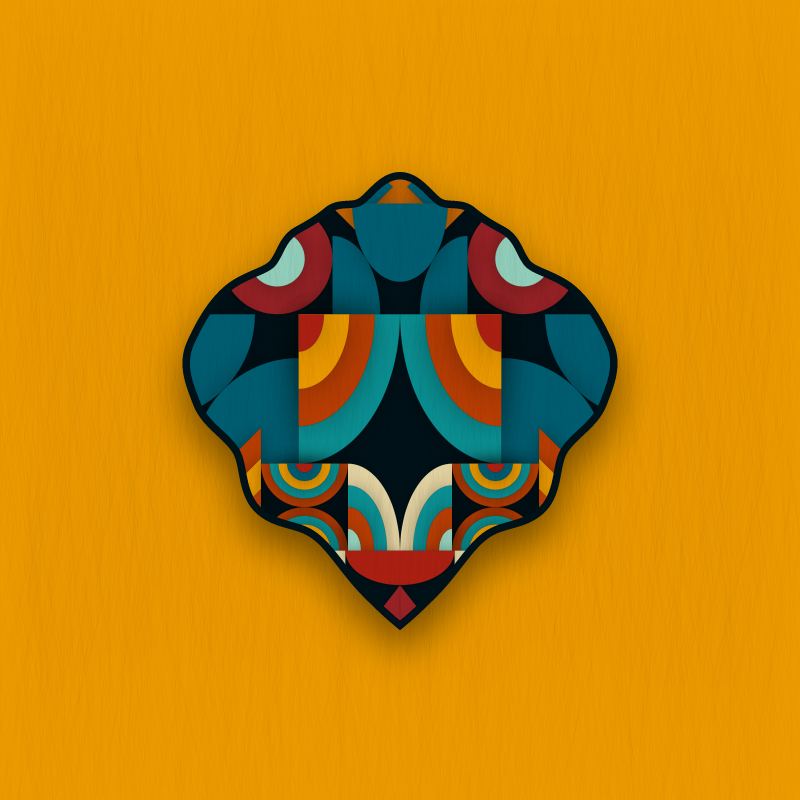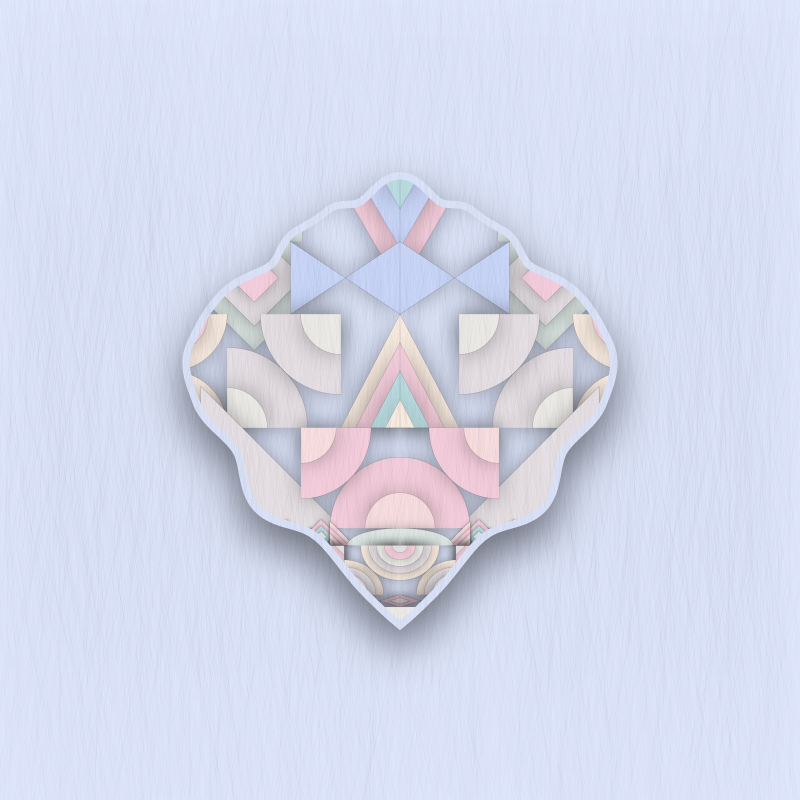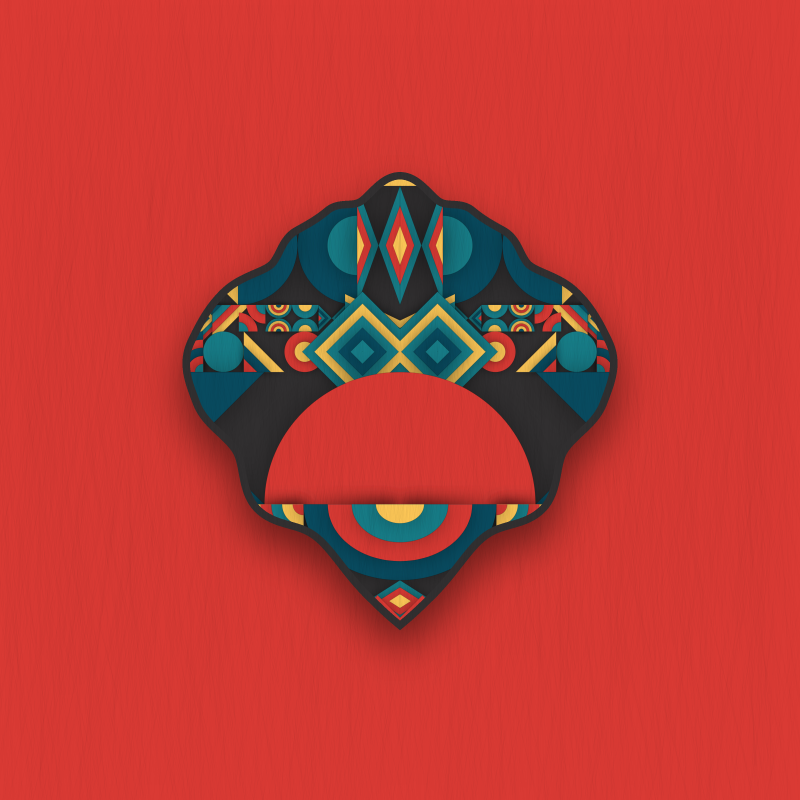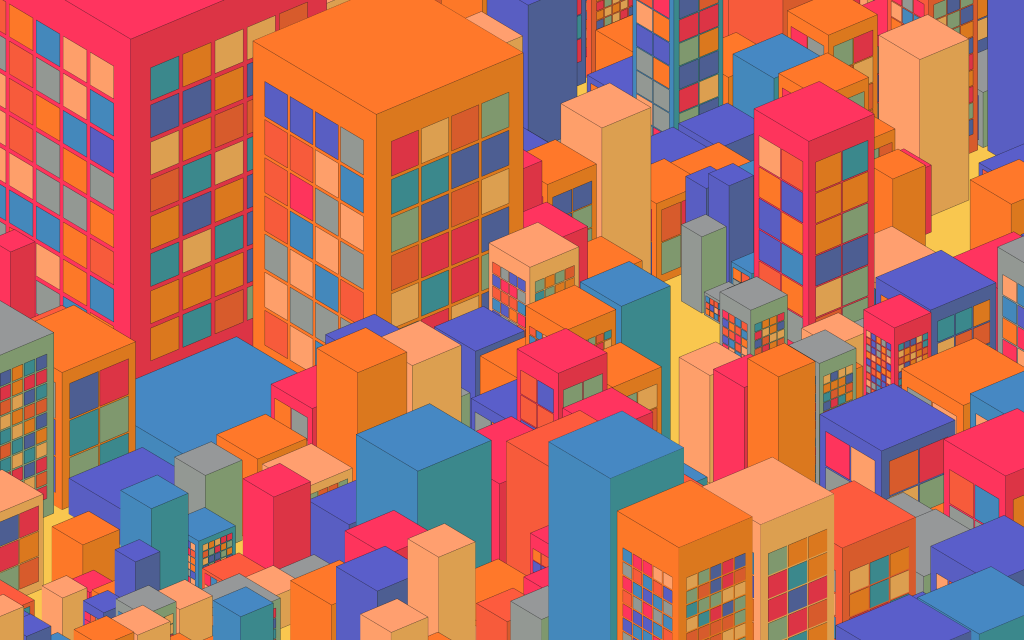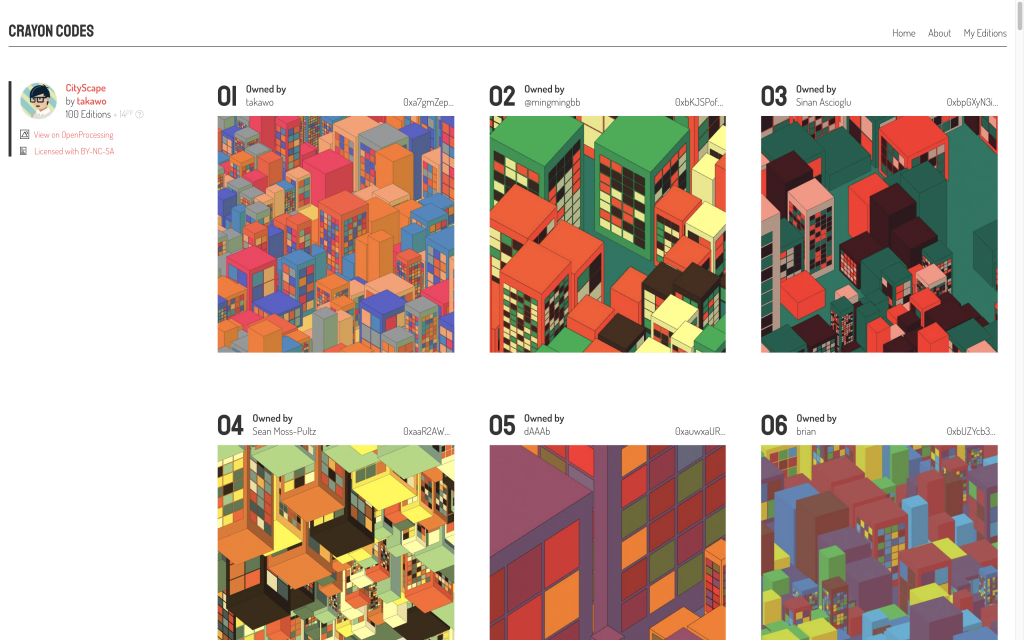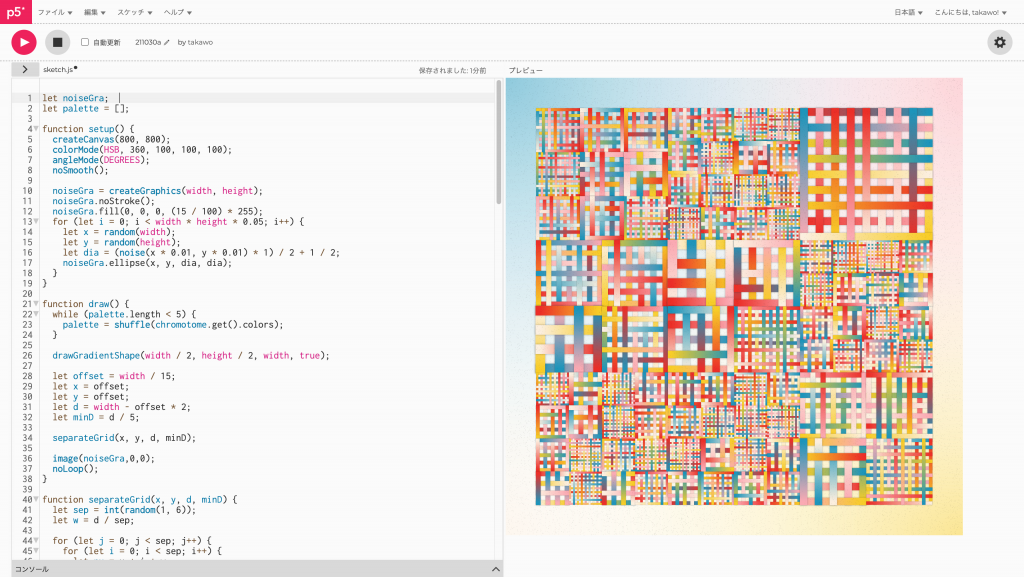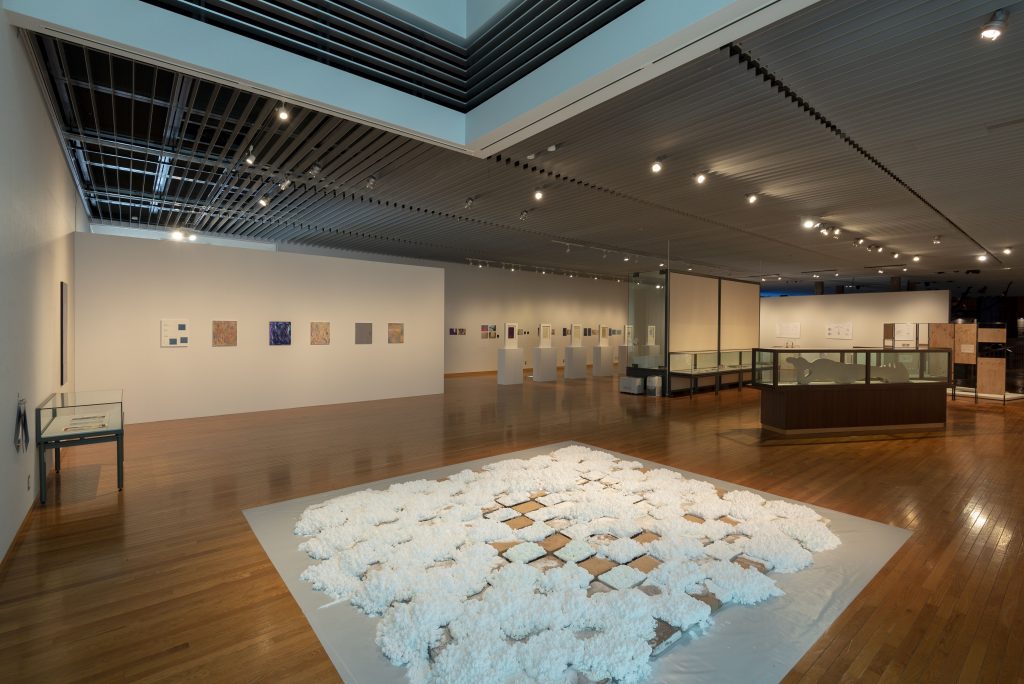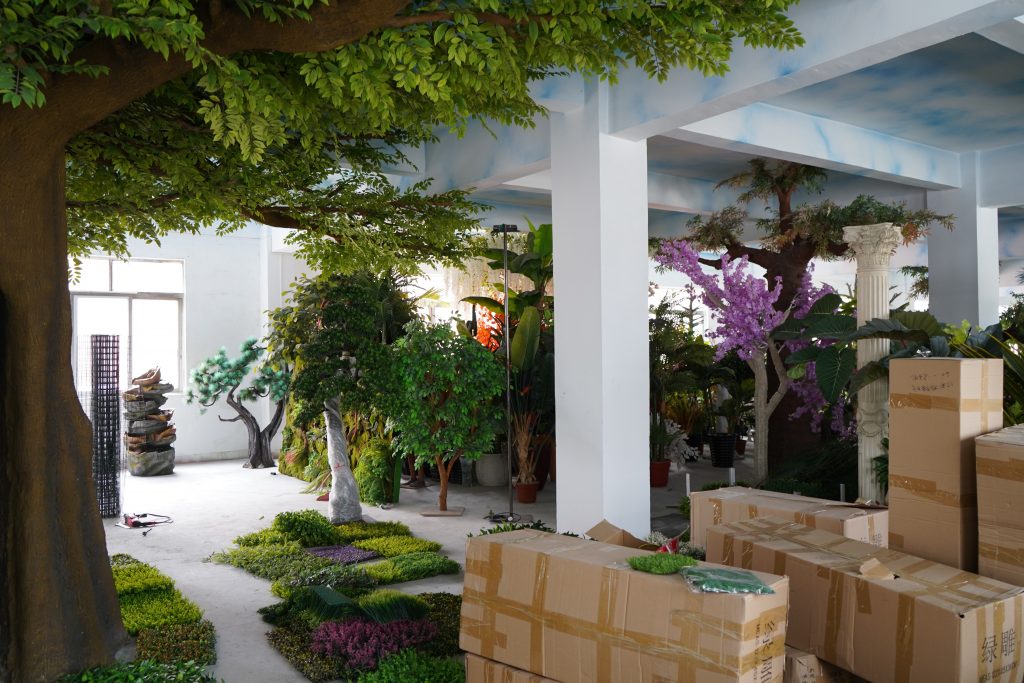The following is an interview with takawo conducted on September 17, 2021. The interviewer was me, ucnv.
On August 17, takawo launched his NFT art project “Generativemasks,” which became a hot topic on OpenSea, an NFT art market, selling out 10,000 units soon after its release. It was a kind of event not only for the NFT art community but also for people involved in programming. This interview was conducted about a month after. Today, about another month has passed since then, and his thoughts and situation must have changed. So this interview is a kind of snapshot. It reflects the murky situation he was caught up in at the time.
I would like to mention the takawo that I know. It was ten years ago when I first heard from him. He was working at the Art Information Center of Tokyo National University of Fine Arts and Music at the time, and he asked me to teach a workshop on glitch art that he was planning for a public lecture [1]. A workshop on computer technology. Looking back on it now, the project was in continuity with his later activities. He supported the Maker movement in Japan, managed the Processing community, and practiced and expanded the “daily coding” activity, which is a casual way to do visual coding. He also ran a computer technology pun contest called the #takawo杯. Consistently, technology and community are the two axes of his activities.
From my point of view, the “Generativemasks” project seemed to be an uncomfortable activity for him. I wondered how it related to his vision of technology and community. It seemed to me that there were too many aspects not related to technology and community. So I thought I wanted to ask the very critical question, “Why did you do it?” if I had the chance. At first, I thought it would be appropriate to sit in on an interview with someone else and ask one or two tough questions from the side. In the end, however, I became the interviewer myself. That’s why I’m asking questions while keeping a critical gaze on our old relationship of ten years. It must be a difficult situation to answer in, and takawo gave me a sincere and easy-to-understand answer.
Geometric and linear, symmetrical shapes create a “lifelike” appearance.
ucnv Before we get into the specifics, can you give us a brief overview of your “Generativemasks?”
takawo As a general description, it is a collection of art traded in a blockchain called NFT Art. The information is available and archived on a website launched at the start of the sale, and can now be viewed and purchased on a marketplace called OpenSea.
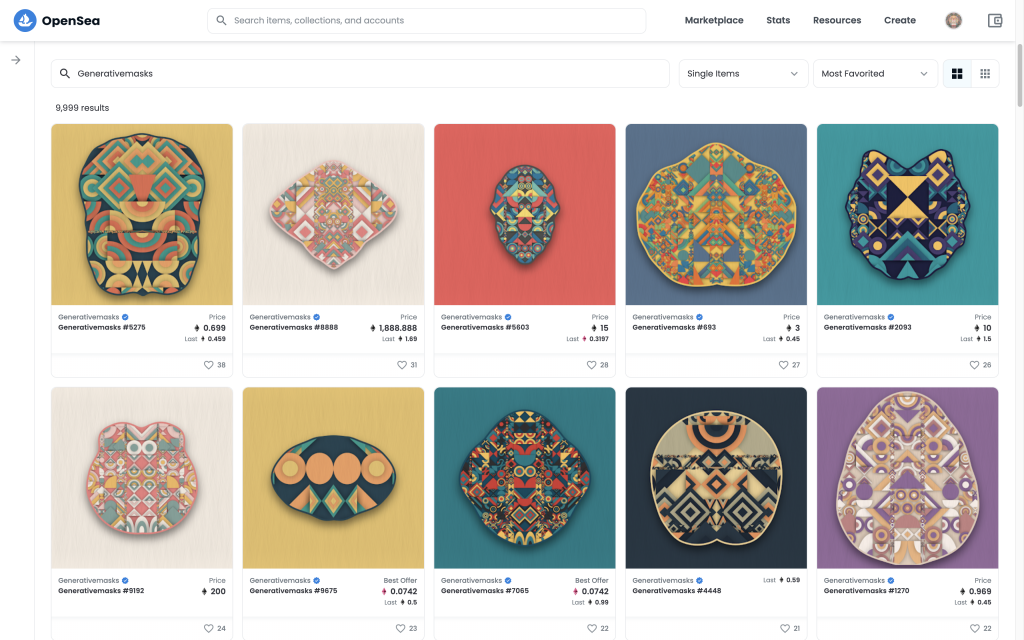
Generativemasks generates graphics by code, and there are 10,000 variations. What makes it a little different from existing NFT art is that the graphic changes every time you reload it, depending on the unique number assigned to it in the metadata. We started at about 10:00am and sold out by about 12:30pm. I recently moved into a new house, and I had to move out at 1:00 p.m. on the day of the event, so I had to be out, and I was really nervous about finishing the sale.
Another great feature of this project is the donation aspect of it. I clearly state on the website that all my personal proceeds will be donated to companies and foundations such as the Processing Foundation, OpenProcessing, NEORT, etc. I’m sure I played some part in the field of generative art and creative coding, but I think people appreciated the donation aspect, the fact that generative art itself is gaining momentum in the NFT world, and the fact that it’s relatively easy to buy, especially with all the attention to different brands like “Art Blocks.” I think the price was relatively affordable despite all the attention to various brands such as “Art Blocks,” which led to the sell-out.
ucnv Are there other people in the project besides yourself?
takawo As you can see at the bottom of the site, Takase and Wildmouse are involved in the development. They’re from TART, a company that supports creators’ sustainable creative activities by using NFT and other blockchain technologies. I hope you can see the relationship as if I were a manga artist and they were the publisher.
ucnv Did the idea to start the mask project as an NFT come from you?
takawo Takase and I were already working on an NFT art project with artists in the Processing community that I am involved in, and he invited me to try selling my works as an NFT. I wasn’t positive about the idea of distributing my works as an NFT at the start, but I wanted to hear about it, and I thought I could get involved in it as a way to try to hack the negative aspects of our excessive market economy. Even before the meeting, I told Takase that it would be nice if we could donate the proceeds. I thought that if it was a charity project, I could find meaning in doing it on a large scale.
ucnv I see. When you set the number of points to 10,000, were you aware of the true nature of the computer’s seemingly violent numbers?
takawo I think that the number 10,000 is the boundary between humans and computers, or rather the limit of human information processing ability. When we held the #takawocup contest, we looked at about 15,000 submissions one by one on a spreadsheet as we made our selections. I felt that I could just about handle 10,000 entries. In my mind, “10,000” is important because I can’t visually check any higher number, and it feels like it would be beyond human capability.
ucnv So it was assumed that everything would be checked visually?
takawo That’s right. This graphic has a “shape” (outline) and an inner “pattern” that develops symmetrically, which I had to check visually. rather than having 10,000 variations, there is a source of 10,000 graphics, and each time I run it, the color variations and placement change slightly. There are 29 variations of a single graphic, and while the outline doesn’t change, there must be 290,000 variations of the graphic.
ucnv I imagine that when you accepted the invitation and formulated your idea, you had a chance to look over the graphics that you yourself had created in the past for daily coding. Did you feel anything when you looked back?
takawo I’m glad I did it, frankly. However, the sketches that became the basis for Generativemasks were a bit special to me. A little discovery in Generativemasks was that by developing a symmetrical combination of shapes and patterns, I was able to create a more human-like experience. I was able to incorporate an element of meaning into the graphics, so that people would feel something like life in them. I had gained a sense of certainty about my own specialty, which is very simple pattern generation, such as combining geometric shapes and painting colors. I am glad to have been able to release it to the world in this way.
However, this was only possible through a period of practice and trial and error. This realization came to me while I was creating various patterns every day, such as using pictograms, making them transparent, developing 3D shapes symmetrically in three-dimensional space, or just using letters. That was my personal breakthrough.
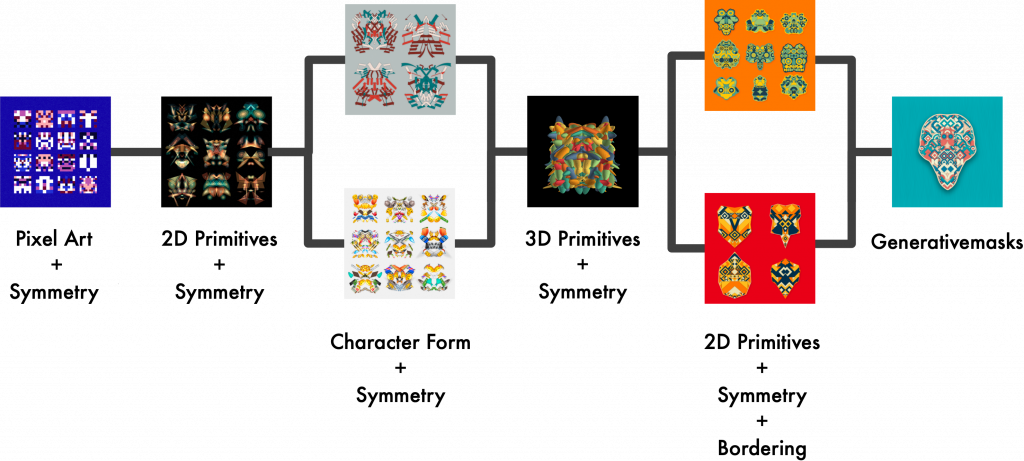
ucnv It seems that there was a time when you were intensively practicing a kind of graphic production similar to Generativemasks, but did that period come to an end at some point?
takawo I don’t know. I think I’m done. My daily coding is both continuous and disconnected. It’s very divergent and tends to dissipate. If the sketches are archived in a form that I can list them, I can think back and go back to the continuation. I try not to divide (the project) too much.
ucnv Recently, you resumed daily coding of mask graphics, and I think Generativemasks is now “coming back” to daily coding, but before coming back, what was your motivation? In what kind of direction was your motivation flowing before you came back?
takawo Hmmm. There are parts that I check while writing code. I’m more comfortable with the term “creative coding” rather than “generative art” or “generative design.” I’m just reaffirming that my own interests, syntax and technical discoveries through the act of coding are important to me. Continuity is not important, but rather making sense of patterns after the fact. It’s a sense of creating the source of an idea.
The True Meaning of Joining the NFT Art Scene
ucnv What was your goal behind introducing your work to the NFT art scene?
takawo As I mentioned earlier, I wanted to hack the system and institutions themselves by reversing negative impressions. With this policy at the core, I started thinking about the direction of the work, like fitting the pieces of a puzzle together, such as making graphics that could be sold in quantity and that would look attractive using my own special techniques. For example, this is the NFT art that I recently sold at Crayon Codes, and I thought that a different kind of graphic would be more likely to reach that kind of audience.
ucnv By “that kind of audience,” do you mean reaching the kind of people who exchange Ethereum via NFTs?
takawo That’s right. I thought it was important to have a certain degree of pop and familiarity, because it’s not like a painting, where there are only a few editions, and I actually felt that I was able to create something like that. It was creepy and cute, but also computer-generated. In that sense, I think it was an appropriate work. Although that’s not a very interesting way of putting it.
ucnv Do you like the look of the Generativemasks?
takawo I like it. Even when I see the masks on my timeline on a daily basis, I feel that they are very fresh, and even though they are my own graphics, there is a moment of mysterious encounter, and I really like that about them. I used ethnic motifs such as yokai (Japanese monsters) and totem poles as references, but in the end, I think I was able to create a sense of life in the work, or perhaps a weirdness like the “stands” in JoJo’s Bizarre Adventure.
ucnv The next question…
takawo Or rather, the way this questionnaire (which I had deployed to takawo beforehand) is written is egregious, isn’t it?
ucnv If you don’t want to answer, please say so (laughs). On the other hand, NFT art is involved in economic investment and does not seem to be a well-developed place for art evaluation. What do you think about that?
takawo No, no, I’ll answer all of your questions. That’s probably true. Especially in Japan, where such views are stronger. I understand what you’re saying. In the creative coding generative art scene where I work, foreign artists are selling their generative art as NFTs. For example, Tyler Hobbs’ series of works called “Fidenza” is selling for as high as 1,000 ETH (about $3.35 million) per work, though I’m sure there are fluctuations. In addition to him, there are other works that are generating huge revenues.
Looking at the activities of Art Blocks, a number of artists who are involved in generative art have entered the project. As I was paying attention to digital art at that time, my suspicion gradually faded away, and from around May, when the first meeting of the project was held, I was no longer negative about developing my own works as NFTs.
ucnv From my point of view, I think that your intentions in creating Generativemasks and the things that you have said so far are not necesarily conveyed to the people who buy them.
takawo That’s right. It is sometimes sensationalized as “the biggest NFT project in Japan, which sold out in two and a half hours,” but I don’t only look at it as that short moment. It’s not a short term thing. The essence of this project is an ongoing effort, and it doesn’t end after the sale. Donations, my personal evaluation, and this activity itself are all linked to the evaluation of the work. In the future, I would like to send out messages through various initiatives to grow the creative coding community in Japan, and I think it is necessary to convey the true significance and value of the project through such activities.
In fact, there are currently about 200 people on the Generativemasks channel on Discord with masks. Including those who don’t have them, there are roughly 2500 people. Members freely discuss coding how-to’s, market assessments, etc., and sometimes they tell me when there is a reference to me on the internet. There’s also a channel for sharing sketches and learning about creative coding to make the collection more enjoyable.
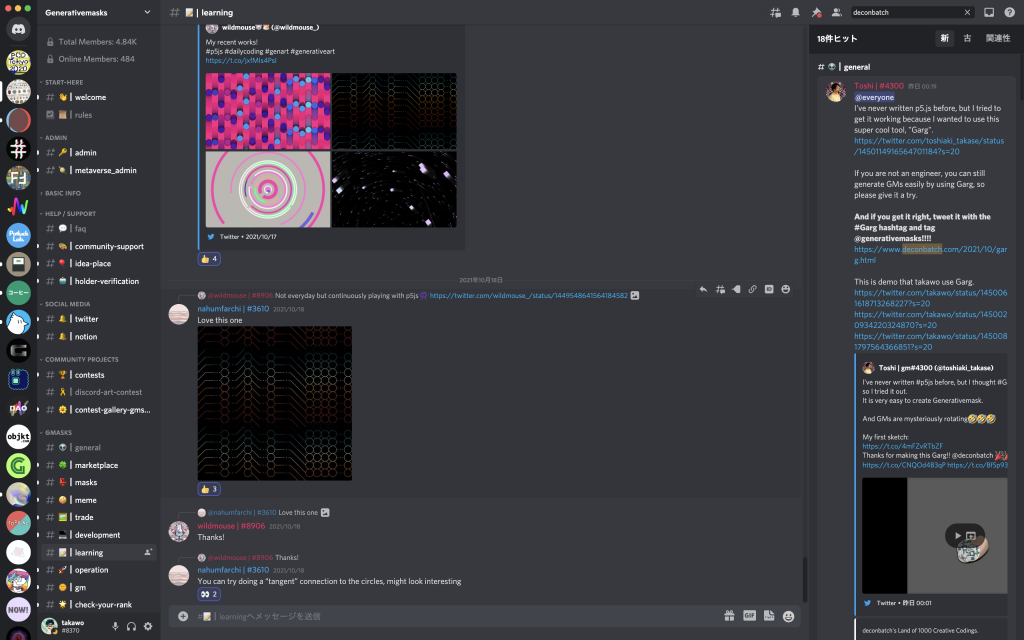
Where it was sold” or “all the works were sold” are just starting points. As long as my passion lasts, I want to continue this project in the same way as daily coding. (I believe that the meaning and value of owning generativemasks will change as it becomes more widely accepted. I think I’m aiming for more than just a “cute mask,” but a badge of honor that shows interest in my activities and creative coding, and a sense of pride in owning a mask.
“Generativemasks have never been valued as more than virtual currency.”
ucnv I see. You say, “Everyone should try daily coding. So I’d like to ask what daily coding is. So, I’d like to ask you what daily coding is. It’s simply “writing code every day”, and apart from that, “publishing” is also a part of this activity. Is it correct to think that these two different activities are what you call “daily coding?”
takawo I think you can also look at it that way. You could say, “I use code as a tool for communication. As a result, I write code every day, but I don’t think that’s important.
ucnv Is there more weight on the expression side?
takawo I’m trying to connect daily life and action, or rather, I’m trying to make writing code not something special. Regardless of the completeness of the code, writing it may bring discoveries and insights to the writer, and sharing the code with others may bring discoveries to someone else.
ucnv I see. This question may sound too basic and rude, but what makes you happy when the act of writing code becomes a part of your daily life, and you discover and realize things? Do you want other people to feel the same sense of accomplishment, joy, and surprise that you have experienced?
takawo That’s right. Maybe I think that way because I’m not a programmer by nature. If I could program from the beginning, I probably wouldn’t be thinking about things like this (daily coding).
I’ve always been on the “can’t do” side. Especially when it came to creative coding and generative art, I didn’t know what to write, and I couldn’t write code without a purpose. I could do tutorials, but I couldn’t go beyond the tutorials. I had these problems, and I kept getting frustrated.
In the midst of all this––and this is just me trying to share my own success story––I’ve been sharing the code I’ve written for the past two years, or “social coding,” as it’s called, by forking (a software engineering term) short pieces of code and referring to someone else’s code. Insights were accidentally stumbled upon, and this became the norm. I hope that this kind of experience will become more widespread, and I think that’s why I’m actively communicating about it.
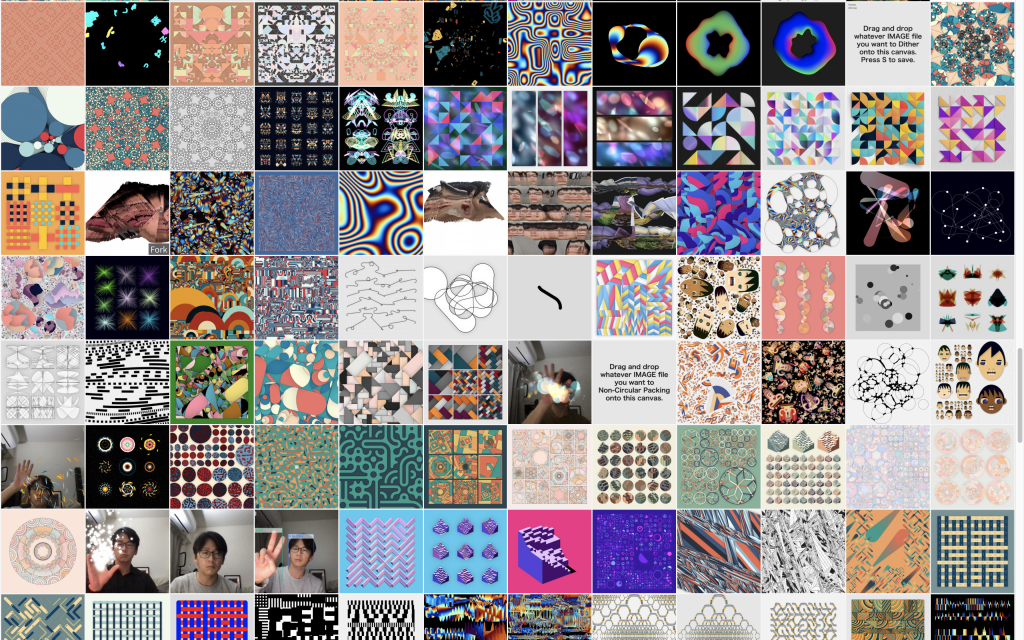
ucnv What exactly do you mean by “the community will grow” as you mentioned earlier? Does it mean that more people will be doing daily coding?
takawo That’s too one-sided. I don’t really think that I want everyone to do the coding that I do. However, as I’ve been involved in the management of the Processing community in Japan, I’ve felt that the community lacks financial resources and manpower, and I think that if funds and people come together to revitalize the community, it would stimulate me, and if the community is managed from a variety of perspectives, it will become more interesting. I have high hopes for it.
While there are negative aspects of NFTs, there are also hopeful aspects, aren’t there? For example, it has been difficult for artists who create works mainly using computers, such as media art, to make money from the sale of their works, but NFTs has created a new way to do so. Leaving aside for the moment how long NFTs will continue to soar, I think this is a very welcome development.
Returning to the topic of generativemasks, even after the sale of the work is over, there will be secondary revenue generated if the work is distributed. I’m thinking of using that money to create an organization like a public interest incorporated foundation. I’d like to support not only the Processing community, but also various other creative coding-related activities in Japan, support research, and support historical positions. From a foreign perspective, the Japanese generative art scene is unique and interesting, but it’s not appreciated because it’s not connected to history at all. So it is very meaningful and purposeful for me to support it.
ucnv It seems to me that the current outlook is coming out with a rather abstract view of “community development” as a goal. For example, if the community has financial resources, or if research is developed, what specific changes will occur for daily coders?
takawo I want to make programming and creative coding more commonplace. I don’t just want to support or raise the level of creative coding in Japan. I want to explore the possibilities of creative coding outside of the computer science and computer science vectors myself.
I’ve been trying to convince ucnv to invest for a while now.
ucnv (laughs).
takawo Oh, but I really want to establish a kind of public interest incorporated foundation. So I want to be able to accept donations like I do. I’m hoping that people who earn money but want to contribute to the community or donate it won’t have to go through the hardships I went through. Right now, about half of the proceeds are taxed.
I hope that people will learn from my case, where I was taxed enormously due to my rash ideas and actions, and if we can create a good system for donations, I think we can repay at least the taxation. So please donate (laughs).
ucnv It’s quite a big deal, isn’t it?
takawo That’s right. And it’s also a little strange to me. A piece of work that changes when it is generated based on the code I wrote takes on a form when it is distributed. There are a lot of people who feel the value in it, and I get a huge amount of virtual currency in my wallet, and I get taxed at that moment. As a solid realization, I felt that this was a lot of pressure.
Moreover, virtual currencies fluctuate in price, don’t they? Even now, there is a possibility that Ethereum will crash. If that happens, I might not even be able to pay my taxes, let alone donate money. If that happens, I’d like to see an NFT project like “Save Takawo” start up (laughs). (laughs) I’m grateful that so many people have paid attention to this project, but I recognize that this project has yet to be evaluated by anyone other than the NFTs, or to be valued as anything more than virtual currency. (Continue to Part 2)
- [1]Workshop by Shusaku Hariya, Yosuke Hayashi, and ucnv, organized by Kazuhiro Jo and Shunsuke Takao, who were teachers at the time↩
